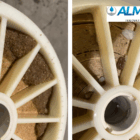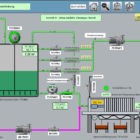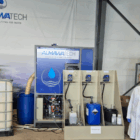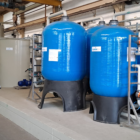Tank truck cleaning and, in particular, tank truck interior cleaning are essential components of industrial processes, especially in the chemical, food and water treatment industries. These cleaning processes produce heavily contaminated wastewater which, due to its specific composition, must be carefully treated before being discharged into the sewage system or reused. The focus in wastewater technology is on efficiently cleaning this heavily contaminated cleaning wastewater and reliably removing pollutants such as oils, greases, chemical residues, organic residues and solids.
Table of contents
Generation of waste water during tank truck cleaning and tank truck interior cleaning
The cleaning of tankers (mobile or stationary) and the targeted internal cleaning of tankers lead to specific wastewater that varies depending on the area of application and the products transported. This wastewater poses particular challenges for water treatment due to its heterogeneity and concentration of pollutants.
1. tank truck interior cleaning
When cleaning the inside of tankers, the main task is to remove residues of liquids, sludge and cleaning agents that were previously transported in the tanker.
Cleaning target:
- Removal of product residues such as chemicals, oils, foodstuffs or acids.
- Ensure cleanliness to avoid cross-contamination during subsequent loads.
Residues in waste water:
- Product residues: oils, fats, acids, alkalis or dyes.
- Surfactants: Residues from cleaning agents.
- Solids: sand, pigments, organic or inorganic deposits.
2. general tank truck cleaning
Tanker cleaning can include both internal and external cleaning. While the focus of interior cleaning is on removing product residues, exterior cleaning is used to maintain and clean the outer surfaces, which also generates waste water.
- Wastewater sources:
- High-pressure cleaning systems and spray nozzles that use large quantities of water and cleaning chemicals.
- CIP (clean-in-place) systems that work automatically and produce waste water continuously.
Characteristics of wastewater from tanker cleaning
The wastewater from tank truck cleaning and tank truck interior cleaning is heterogeneous and often highly concentrated due to the large number of transported products and cleaning processes. It has the following main characteristics:
1. high organic load
- Residues such as oils, surfactants and organic chemicals lead to an increased chemical oxygen demand (COD).
- Especially when cleaning tankers that have transported food, oils or chemicals, the COD value is often very high.
2. oils and fats
- Mineral, vegetable and animal oils are often contained in wastewater. They must be separated using special processes such as oil separators, as they represent a high environmental impact and can disrupt wastewater treatment processes.
3. heavy metals
- Heavy metals such as chromium, zinc, copper or nickel can get into the wastewater when cleaning the inside of chemical tankers. These require targeted chemical-physical separation processes such as precipitation and flocculation.
4. solids and suspended matter
- Solids pollution is caused by residues such as:
- Pigments from varnish or paint residues.
- Sludge from tank cleaning.
- Sediments such as sand or dust particles.
- These suspended solids increase the turbidity of the wastewater and must be removed by sedimentation or filtration.
5. variable pH values
- The use of acids or alkalis for cleaning leads to strongly fluctuating pH values in the wastewater.
- Neutralization is essential for subsequent wastewater treatment in order to achieve a pH range between 6.5 and 8.5.
Wastewater treatment process
1. oil separator: removal of oils and greases
Function and principle
Oil separators separate oils, greases and other light liquids from water. The operating principle is based on the difference in density between oil and water:
- Light liquids such as oil float on the surface of the water due to their lower density, while heavier substances sediment.
- Heavy particles such as sand or silt are deposited in the sludge area.
Procedure
- Coalescence separator:
- Separation is improved by coalescing elements that bring oil droplets together and form larger oil clusters. These rise to the surface more quickly.
- Standard oil separator:
- Efficient in the treatment of wastewater with free-floating oil.
- Two-stage oil separator:
- Integrate a sludge trap zone to remove solids prior to oil separation.
Treatment steps in the oil separator
- Run-in zone:
- Calming the flow to ensure even distribution.
- Coalescence area:
- Formation of larger oil clusters and their deposition on the surface.
- Sludge trap:
- Deposition of heavy particles such as sand and silt.
Advantages of the oil separator
- Effektive Entfernung von Ölanteilen bis zu Konzentrationen von < 20 mg/L.
- Protects downstream systems from blockages and overloads.
- Cost-efficient pre-treatment for heavily oil-contaminated wastewater.
2. chemical-physical treatment in flotation plants
After oil separation, finely dispersed oils, fats and dissolved substances remain in the wastewater. These are removed in a flotation plant by chemical conditioning and physical separation.
Function and principle
Flotation uses fine air bubbles to transport particles and the finest oil droplets to the surface, where they are skimmed off as sludge. Chemical reagents improve the separation performance.
Procedure
Chemical conditioning:
- Precipitant:
- Iron or aluminum salts (e.g. FeCl₃, Al₂(SO₄)₃) for the precipitation of dissolved substances.
- Binding of phosphates or heavy metals.
- Flocculant:
- Organic polymers promote the formation of large, stable flocs that are easy to separate.
- pH adjustment:
- Neutralization of the wastewater by adding acids (e.g. sulphuric acid) or alkalis (e.g. caustic soda) to an optimum pH value of 6.5-8.5.
- Precipitant:
Flotation process:
- Air bubble formation:
- Fine air bubbles are created by pressure release or diffusers.
- Adhesion to particles:
- The air bubbles bind to the flakes or oil droplets, which rise to the surface due to the buoyancy.
- Sludge discharge:
- The foam formed on the surface is continuously skimmed off.
- Air bubble formation:
Advantages of the flotation system
- Efficient separation of the finest oil droplets and particles.
- Reduction of the chemical oxygen demand (COD) and the suspended solids load.
- Suitable for highly contaminated wastewater with variable composition.

Photo: Our ALMA NeoDAF flotation system for the treatment of wastewater from tanker and silo cleaning with automatic addition of precipitants and flocculants
3. neutralization
During the chemical-physical treatment, the wastewater is neutralized to stabilize the pH value in the neutral range.
Procedure
- Acids (e.g. sulphuric acid) or alkalis (e.g. caustic soda) are dosed to adjust the pH value in the neutral range (6.5-8.5).
- Online pH meters and automatic dosing systems ensure precise control of the process.
Goals
- Protection of the downstream gravel filters from chemical contamination.
- Compliance with legal requirements for pH value before discharge or reuse.
4. filtration through gravel filter
The final treatment is carried out by gravel filterswhich remove fine suspended solids and residues from the wastewater.
Structure of a gravel filter
- Multi-layer systems with different filter layers:
- Top layer: Fine quartz sand to remove the smallest particles.
- Middle layer: Coarse-grained gravel to stabilize the filter layer.
- Bottom layer: Base layer of coarse gravel for even water distribution.
Functionality
- The wastewater flows through the filter from top to bottom.
- Particles and suspended solids are retained by mechanical filtration and adsorption.
Advantages of gravel filtration
- Entfernung feiner Partikel bis zu einer Größe von < 10 µm.
- Cost-effective and simple technology with minimal maintenance requirements.
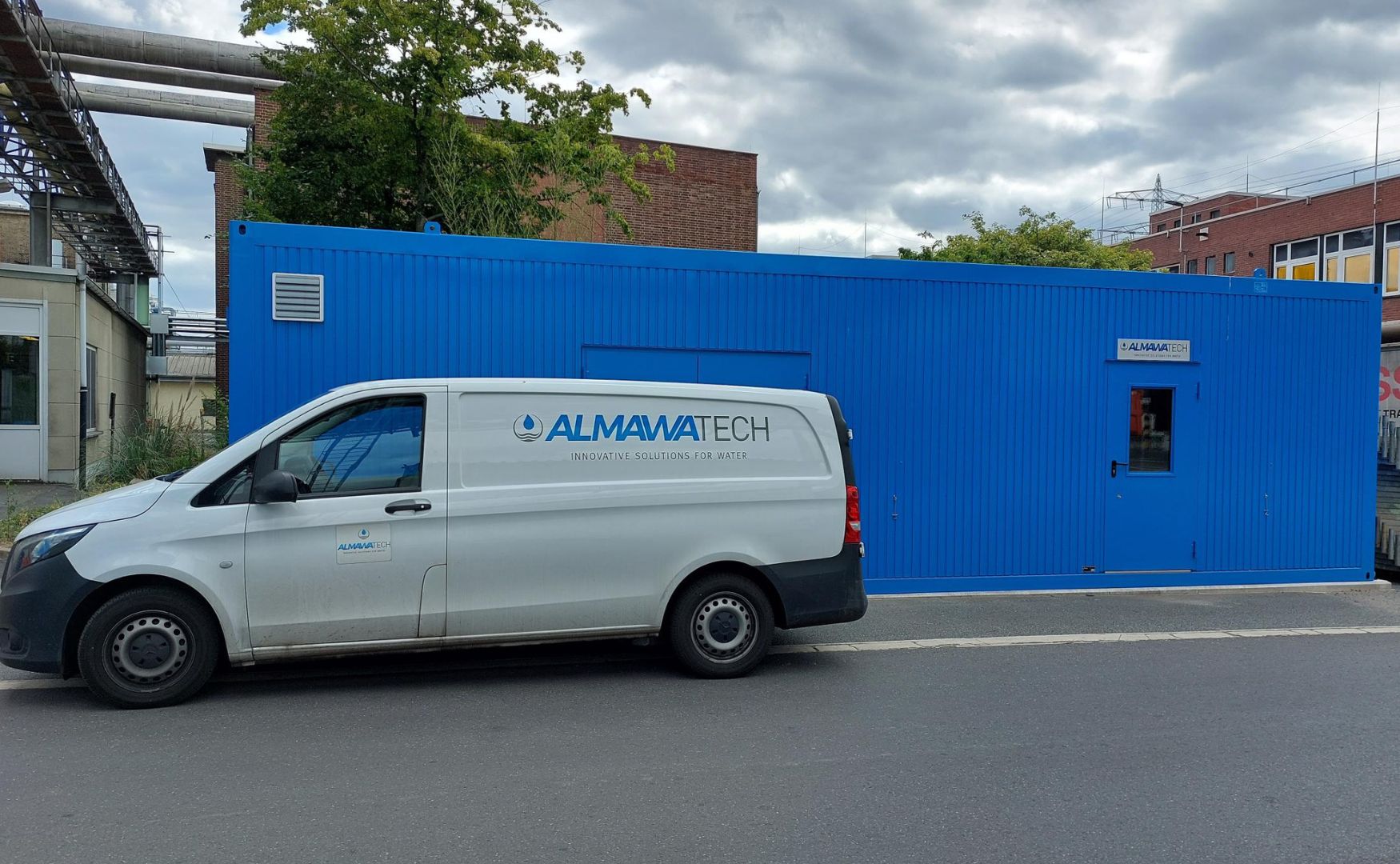
Photo: Our ALMA NeoDAF flotation system with downstream gravel filter for the treatment of wastewater from tanker and silo cleaning, installed in the ALMA Modul technical room container.
Special requirements for the treatment of wastewater from tank truck cleaning
Heterogeneous composition of the wastewater
The wastewater from tanker cleaning varies greatly depending on the type of contents previously transported. Residues such as oils, greases, chemical residues, heavy metals, surfactants and solids require flexible treatment.
High peak loads
High wastewater peaks often occur during internal tanker cleaning, both in terms of volume flow and pollutant concentration. Buffer tanks for wastewater homogenization are therefore essential in order to:
- To compensate for hydraulic fluctuations that could overwhelm subsequent treatment processes.
- This is to cushion material concentration peaks and ensure constant wastewater quality.
A uniform feed into the treatment plant thus enables continuously efficient cleaning.
Regulatory requirements
The treatment of tanker cleaning wastewater is subject to strict regulatory requirements which, depending on the region, are defined by the Water Framework Directive (WFD) or local ordinances. The most important parameters include
- COD (chemical oxygen demand): Limit values are usually below 200 mg/L in order to minimize organic pollution.
- Heavy metals: Values for chromium, zinc, nickel or copper must be below specific limit values, depending on the pollutant.
- Oils and greases: Free oils must not be contained in the wastewater and must be safely separated before discharge.
Compliance with these limit values is not only mandatory from a legal perspective, but is also crucial for the protection of wastewater treatment plants and water bodies from harmful discharges.
Conclusion
Tanker cleaning, in particular internal tanker cleaning, produces highly contaminated wastewater that requires careful treatment tailored to the load.
The combination of oil separators, neutralization and flotation technology ensures effective two-stage treatment. This allows pollutants such as oils, heavy metals and organic residues to be efficiently removed and the legal discharge limits to be reliably complied with.
For further information on our products, please feel free to contact us at any time!


